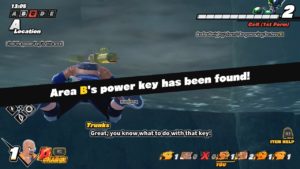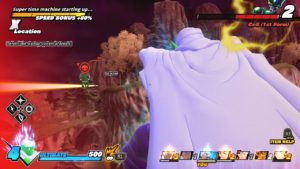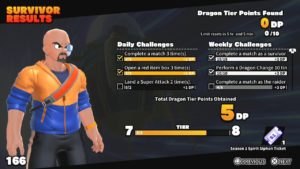There are fewer bigger franchises than “Dragon Ball”. Spanning for almost forty years and being able to cross continental bounds, “Dragon Ball” has become more than just a manga or anime. As per the norm with successful franchises, Akira Toriyama’s fantastic creation moved beyond its typical avenues of entertainment thanks to the advent of certain mediums unable to capture the spirit of his works including video games. Thanks to the way “Dragon Ball” and its sequels have been presented in its base form, “DB” games have mostly stayed in the realm of fighters or re-telling the heralded stories & arcs loved (and at times loathed) by the fanbase.
Wanting something different from a “Dragon Ball” video game, developer Dimps looked at the current gaming landscape and figured out how “Dragon Ball” could fit in a PVP, asymmetrical environment. What came of this idea is now known as “Dragon Ball: The Breakers” – a seven-versus-one multiplayer experience that produced multiple betas including the last two that yours truly enjoyed a lot. Though the entertainment for a short time during those betas was there, a general uneasiness about the game’s longevity and potential use of micro-transactions put some worry into this would-be Z Fighter when the game released in its final form.
Did I Complete “Dragon Ball: The Breakers”?
The initial explanation of what makes up “The Breakers’” mechanics is hastily introduced via a skippable tutorial where adult-age Trunks explains how a Temporal Seam anomaly has allowed the likes of Frieza, Cell, and Majin Buu to enter the world Trunks and various other humans are occupying including a player-created avatar via the rather miniscule character crafting items available. It is also through the tutorial players are told how to generally overcome the fearsome foes be it through science or hand-to-hand combat.
Very similar to many games in the genre before it, “The Breakers” in its current form is not complete thanks to planned seasons, constantly changing challenges for the player to complete for those precious “Dragon Points” that increase the “Dragon Tier’s” bar where players will unlock various customizable items or earn currency depending on how far they are progressing on the “Tier”, and particular rewards also being shifted in and out of the game’s one of two shops. The best way to judge completion of “The Breakers” as of this time is through the trophy/achievement list that includes some relatively challenging and, at times, luck-based requirements including wiping out all the Survivors with a Raider, collecting the seven Dragon Balls to call upon Shenron, and escaping via the Time Machine with at least three Survivors hanging on for dear life.
For yours truly, a majority of the trophies came easy, but the grind of getting a Raider up to level thirty and completing fifty matches with either Frieza, Buu or Cell has been absurdly inconsistent as it can take anywhere between three and ten games of being a Survivor before getting the chance to control a villain – an issue that will definitely keep me away from the platinum trophy for a while.
What Makes “Dragon Ball: The Breakers” Unique?
Though the tutorial does explain “The Breakers’” general gameplay mechanics for the Survivor, a lot about how to succeed or fail a mission no matter what side of the Seam the player is on comes through trial and error upon playing multiple rounds. Survivors have several avenues to win, but they all take time and can be ineffective depending on how well the Raider is at both gathering energy to evolve and discovering the locations of every active Survivor. The Survivor’s first main objective is finding five “Power Keys” with each being associated with a particular zone of the map: “A”, “B”, “C”, “D”, and “E”. When a Survivor finds one of the Keys, any other Survivor including the initial finder can set up the Key in its designated spot. With at least four Keys stationed, the “Super Time Machine” appears on the map that, when fully activated, obliterates the Raider from all time & space (at least until the next round).
The Super Time Machine isn’t the be-all, end-all in terms of Survivor success as the Raider can also destroy the Super Time Machine. If the Super Time Machine isn’t activated in first ten or so minutes of the round’s fifteen-minute time limit (though the in-game clock ticks down a lot faster than in real life), Trunks will announce the arrival of stations where a smaller time machine can be called upon for an escape. Unlike the Super Time Machine, the escape-oriented Time Machines can’t take much damage including a couple of Ki blasts from the Raider. Multiple players can latch onto the escape Time Machine. Once one escape-focused Time Machine is called upon and either successfully transported from the Temporal Seam or is destroyed, there’s a cool-down before another can be summoned.
The most exciting, though hazardous way to win against the Raider is by transforming into one of the Z Fighters via the “Dragon Change” ability. As Survivors go around the map, there will be blue and red boxes holding various items including weapons like one-use rocket launchers that stun hit Raiders, barrier-restoration canisters to prevent a quick death after falling to a Raider once in the round (Survivors have only two knockdowns by a Raider before they die), and power cubes that fill up the Survivor’s Dragon Change meter. When the Dragon Change meter reaches level one of three, it can be activated so the player can either fight the Raider or make a high-powered escape that needs a cool-down before the mode is utilized again. With the option of finding or buying “Cooldown Drinks” at one of the vending machines placed around a map, waiting for the Dragon Change meter to recharge is reduced.
Fighting the Raider, however, presents one of the game’s biggest problems as the mechanics for fighting are not very good. Featuring a swirling camera, finicky lock-on system, mid-fight animations that remove the Raider from sight without stun locking the foe and prevents adjustment of, say, a Special Beam Cannon projectile so it’ll hit its target, and the general rock-paper-scissors-like clashes, the combat leaves a lot to be desired and something that really can’t be updated beyond fundamental changes to the overall presentation.
Combat is made worse by the fact energy is essentially the Survivor’s temporary health when in Dragon Change mode and being hit drains Survivor energy tremendously even at level four – a level that can only be obtained by summoning Shenron via the Dragon Balls (Dragon Balls are usually found via the aforementioned item boxes and rescued Namekian citizens). The Raider, however, has a significant pool of health and unlimited energy with a cool-down timer connected to the Raider’s special attacks being the only thing stopping a Raider player from obliterating a single Survivor quicker than normal. Thankfully for Survivor players, charged Survivors en masse can usually stop a level two or even three Raider if everything goes perfectly.
Dragon Change settings tie into the abilities and skills of the player’s character. In the main hub, players can switch out Z Fighter “Spirits” and put them into one of the three available slots associated with the created character’s Dragon Change. Depending on the slot position, the player will not only transform into that character when Dragon Change is activated, but also have active & passive abilities and a Super Attack associated with that chosen “Dragon Ball” character. For example, putting a Gohan with the “Flying Nimbus” active ability and “Kamehameha” Super Attack in the third slot will provide the player the option to call upon the flying cloud when not on Dragon Change mode at all times (minus the cool-down time) while giving the character a Kamehameha blast attack if the player activates their Dragon Change once the meter reaches level three.
While active skills are both player-chosen and used when moving around a map, passive abilities work all the time for a player’s avatar including a grade-three Piccolo providing a greater barrier to avoid a Survivor’s downfall when attacked by a Raider. All the Survivor skills & abilities are upgradable via “Super Warrior Spirits” gained through match completion and moving up the “Dragon Tier” ladder. Sadly, most of the active skill upgrades only reduce the cool-down timer by a tenth to a half of a second – something that may mean absolutely nothing in terms of waiting considering some skills like calling the Saiyan Escape Pod has a cool-down time of three minutes.
The skills & abilities system brings to light the game’s biggest flaw: micro-transactions. It is through the “Spirit Siphon” that the game’s gambling system is presented. The Spirit Siphon system allows players to spend currency to purchase draws featuring the Z Fighters who are graded on rarity levels rated up to five stars. While players can use the money/“Zeni” earned from playing the game, the cost for one Siphon summon is up to 15,000 Zeni. Zeni is obtained when smashing objects or opening up boxes during a gameplay session and when completing a match with the better match result grade garnering more Zeni. On the opposite end of Siphon summoning pricing is “TP Tokens”. TP use costs only 150 per Siphon, but the amount given to the player through just gameplay is miniscule after every time the player’s character levels up (while a Siphon ticket is offered for every five levels) and certain completion levels on the Dragon Tier.
The best way to get TP is by using the in-game shop where players can spend real money anywhere between two dollars for 200 TP Tokens to forty-five bucks for 5400 Tokens – almost double the price of the base game itself in regards to the highest amount. Sadly, duplicate Spirits are not out of the ordinary considering the small reward pool initially, but the player is paid back in Super Warrior Spirits as compensation. Though the game does feature a gambling system, the fact Survivors are generally so weak even at higher levels compared to the Raider, having the best skills and/or highest grade Z Fighters equipped won’t help much against a Raider player who both knows what they’re doing and too is leveling up their Raider & said Raider’s skills & abilities. TP Tokens can also be used to buy certain customizable items including clothing and intros for both Survivors and Raiders. Thankfully certain active skills available for purchase can only be done so with Zeni and are relatively cheap at 8,000 Zeni per skill.
On the opposite end are Raider skills that can’t be changed, but only upgraded with skill points earned when leveling up that Raider between gameplay sessions. Like the Survivor skill and ability upgrades, a majority of a Raider’s upgrade paths are connected to reducing the cool-down timer; though some increase damage, range and duration of a Raider’s special attacks or abilities. Raider gameplay is quite different from being a Survivor as a Raider player must not only hunt down the Survivors, but also citizens scattered around the map.
Once a Raider reaches a particular threshold of energy consumption, the Raider evolves with each of the three evolutions giving the Raider the ability to destroy one of the map’s zones and anything in that zone including Survivors. Unlike Survivors who have multiple paths of success, the only way to win as a Raider is to kill as many Survivors as possible while preventing the Super Time Machine from starting. Survivors can escape via the regular Time Machine, but as long as the Raider still has health when there are no more Survivors active on the map – either dead or escaped – it’s considered a win for the Raider (though escaped Survivors get a victory screen as well).
While each Raider plays the same in general, their skills, abilities, and evolutions are what differentiates them from one another. Cell starts off in a not-so-vulnerable larva state before transforming and being able to use some of the Z Fighter’s special Super Attacks. Majin Buu has to be hatched via energy collected by Spopovich & Yamu with Buu’s final form – Kid Buu – only unlocking when the Survivors are absorbed into it and one of the players removes the captured Majin Buu from Super Buu’s insides just like in the actual “Dragon Ball Z” story. Frieza too can call forth help in the form of Zarbon and Dodoria who will scout for and attack Survivors before Frieza evolves into, arguably, the quickest Raider with exceptionally fast normal Ki blasts to complement its long windup in terms of Super Attacks. Raiders can also summon Shenron by picking up Dragon Balls dropped by downed Survivors.
Sadly, getting to play as a Raider is a lot more difficult than expected. Instead of implementing a system like “Dead By Daylight” or the recently released “Evil Dead: The Game” where the player chooses whether they want to be a Survivor or Raider before entering the matchmaking process, “The Breakers” follows the lead of “Friday the 13th: The Game” and “Predator: Hunting Grounds” where the player sets their play priority and hope that they get to be on the side they want. The matchmaking system definitely doesn’t take into account player levels as a Survivor team can be populated by players ranging from level one to level forty-plus while a Raider may be at level fifteen taking on a bunch of low-level first-time players.
Survivor levels really don’t matter in the grand scheme of things as base stats or abilities don’t increase when a Survivor’s character levels up while Raiders actually gain a skill point for every level. It is wise to wait and let the game session finish as Survivor players are given the option to leave after dying, but only obtain the amount of experience earned up to that point. If the session actually turns in the Survivors’ favor, a deceased Survivor benefits from that success as long as the player hasn’t left the session. There is no voice chat between Survivors which may be a detriment considering how teamwork is so imperative for success. Unfortunately, there is no cross-platform play as well; subjecting players to their hardware of choice.
Technically, “The Breakers” is inconsistent at best and unplayable at worst. The rudimentary graphics don’t compare to the rather stellar sound presentation with the latter mostly due to the Survivor’s increased heart rate heard when a Raider is close. Stability is a mixed bag. Moments such as infinite loading screens, Raiders glitching out due to players leaving/disconnecting, and even the in-game clock getting stuck while the Raider goes on a killing spree surprisingly happened a lot more than expected even in the first week of release considering how long the game was in beta form. There were also times when only six Survivors would be chosen to start a game; putting the Survivor team one person short where as many hands are needed to stop a Raider player.
Though it appears that the game is setting up a story adding to the “Dragon Ball” lore or even presenting itself as non-canonical offshoot, there really isn’t any meat to chew on in terms of a narrative after the initial presentation via the tutorial. Depending on how the Survivors succeed or fail in their mission to escape or annihilate the Raider, a short cutscene will play to end a session and the player is transported back to the floating island similar to Kami’s Lookout to do it all over again. The few characters also on the base spout one to two lines of dialogue and that’s it in terms of any type of plot.
Even though this is a budget title, there is a lot to like and loathe about “The Breakers” including the heart-pounding cat & mouse scenario and the distressingly implemented combat respectively. Hopefully updates, patches and general balancing will allow for “The Breakers” to reach its potential.
Should You Play “Dragon Ball: The Breakers”?
Gamers tired of the asymmetrical multiplayer genre will find little to nothing to like about “The Breakers”. The powerless nature of a Survivor against a gigantic Raider is thrilling a majority of the time and being a mostly all-powerful Raider is nothing short of exhilarating. Even at twenty dollars, the free-to-play model that is rooted in the game’s economy, unpolished combat system, and technical issues out of the gate causes “The Breakers” to struggle in earning anything more than its relatively low price tag.
With time and the developers potentially working out some of, if not a majority of the kinks, “The Breakers” can transform into a fine, though unremarkable game in a rather flooded genre only helped by the license associated with the game. Trophy and achievement hunters, though, better jump on this one as soon as possible if they’re interested, while casual gamers should wait a few months to see how much gets fixed; though there is always the chance the player base could drop off significantly before those important repairs are administered.
While “Dragon Ball: The Breakers” fails to fully rock the dragon, there’s definitely an undeniable joy when obliterating so many hopeful Survivors thinking they can escape a Raider’s exponential power or making a Raider player furious for slipping out of their destructive grip.







